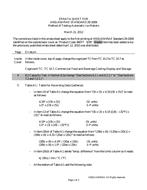States that mechanical ventilation systems installed in some large industrial buildings may be complex in design and handle large air supply rates of tens of thousands of cubic meters per hour. Commissioning procedures, concerned with flow rates for example, generally are not capable of detecting how efficient the system is in supplying air to those locations where it is needed. However this efficiency may be expected to have a significant impact on energy consumption and indoor air quality and affect the response of the ventilation system to changes in load. Describes how the air exchange efficiency of a large, mechanically-ventilated industrial hall was measured using a tracer gas technique (step-up method). Results showed that a significant proportion of supply air bypassed the working area (short-circuiting), which indicated that infiltration was substantial. Derives a new approach to evaluate the air exchange efficiency using the step-up method in real buildings, taking account of infiltration.
KEYWORDS: Ventilation, mechanical ventilation, buildings, industrial, measuring, halls, air change rate, efficiency, air infiltration, tracers, air supply
Citation: Symposium, ASHRAE Trans. 1991, vol.97, part 2
Product Details
- Published:
- 1991
- Number of Pages:
- 9
- File Size:
- 1 file , 1.2 MB
- Product Code(s):
- D-18381


